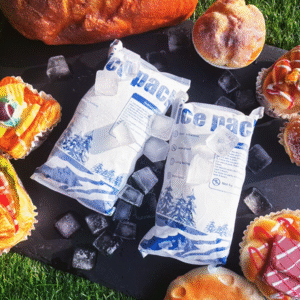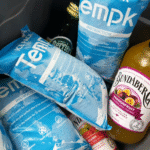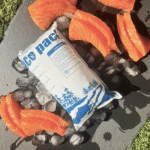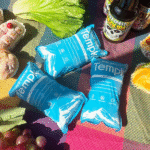هي حقيبة مايلر آمنة للثلج الجاف? أ 2025 دليل سلسلة البرد
قد تتساءل عما إذا كانت حقيبة مايلر يمكنها حمل الثلج الجاف بأمان للشحن أو التخزين. تُستخدم أكياس مايلر على نطاق واسع في سلسلة التبريد لأنها تمنع الرطوبة, الأكسجين والضوء. الجليد الجاف, لكن, يتسامى إلى غاز ثاني أكسيد الكربون عند درجة حرارة شديدة البرودة -109.3 درجة فهرنهايت (-78.5 درجة مئوية), ويمكن للغاز أن يزيد الضغط إذا كان محصوراً. يشرح هذا الدليل متى تكون حقيبة مايلر مناسبة, مخاطر دمجه مع الثلج الجاف وكيفية الحفاظ على شحناتك متوافقة وآمنة.

ما الذي يجعل أكياس مايلر مميزة لتعبئة سلسلة التبريد؟? تعرف على تركيبتها المصنوعة من مادة PET والألمنيوم ولماذا تعتبر مثالية للمنتجات الغذائية والصيدلانية.
نكون أكياس مايلر آمنة للثلج الجاف تخزين? افهم مخاطر ضغط ثاني أكسيد الكربون, عندما تكون التهوية مطلوبة ولماذا قد يكون إغلاق الكيس بالكامل خطيرًا.
كيف يمكنك منع التمزقات عند الجمع بين أكياس مايلر والثلج الجاف? اتبع إرشادات السلامة خطوة بخطوة, بما في ذلك العزل, أكياس مزدوجة الطبقات والتهوية.
ما هي البدائل الأكثر أمانًا لمايلار للثلج الجاف? قارن بين أكياس الثلج الجاف ذات التهوية, حاويات رغوة EPS وحزم هلام, مع إيجابيات وسلبيات لكل منهما.
ما هو الجديد في التعبئة والتغليف سلسلة التبريد في 2025? استكشف الاتجاهات مثل أجهزة الاستشعار الذكية, مواد مستدامة وأنظمة أكثر صرامة للبقاء في صدارة المنافسين.
ما الذي يجعل أكياس مايلر مميزة في عبوات السلسلة الباردة?
يتم تصنيع أكياس مايلر من مادة البولي إيثيلين تيريفثاليت الملائمة للطعام (حيوان أليف) مع طبقة معدنية, خلق حاجز فعال ضد الأكسجين, الرطوبة والضوء. عن طريق منع هذه العناصر, تعمل أكياس مايلر على إطالة العمر الافتراضي وتحمي المحتويات الحساسة, مما يجعلها شائعة لتخزين الأطعمة الجافة على المدى الطويل, الأدوية والعينات البيولوجية. يوفر فيلم PET - المعروف أيضًا باسم البوليستر ثنائي المحور - قوة شد عالية, الاستقرار الكيميائي وخصائص حاجز الغاز. عندما تكون مغلفة برقائق الألومنيوم والبوليمرات الأخرى, والنتيجة هي حقيبة محكمة الغلق تقاوم الثقوب وتوفر متانة استثنائية.
تكوين المواد وخصائص الحاجز
ينبع نجاح مايلر في سلسلة التبريد من بنائها متعدد الطبقات. الطبقة الخارجية من بلاستيك PET, تم اختياره لقوته ومرونته. الطبقة المعدنية الداخلية (عادة الألومنيوم) يعكس الحرارة ويحجب الضوء, بينما توفر الطبقة الثالثة من البولي إيثيلين إمكانية الغلق الحراري. يشكل هذا المزيج حاجزًا غير منفذ يمنع الأكسجين, الرطوبة والضوء. في الممارسة العملية, وهذا يعني الحبوب, تظل الوجبات أو الأدوية المجففة المخزنة في كيس مايلر محكم الغلق ثابتة لسنوات دون تبريد. نفس الخصائص تجعل أكياس مايلر بطانة شائعة للدلاء والكرتون لأنها تمنع الروائح من الهروب وتقلل من التلوث..
| عنصر | دور في حقيبة مايلر | تستفيد لك |
| فيلم PET (الطبقة الخارجية) | يوفر القوة والاستقرار الأبعاد | يقاوم التمزق ويحافظ على سلامة الحقيبة أثناء النقل |
| الألومنيوم أو طبقة معدنية | يخلق حاجزا للضوء, الأكسجين والرطوبة | يحافظ على المحتويات طازجة, يمنع الأكسدة والتدهور |
| البولي إيثيلين (الطبقة الداخلية) | يتيح الختم الحراري ويضيف المرونة | يسمح بأختام محكمة الغلق وتغليف سهل |
نصائح عملية لاختيار حقيبة مايلر
حدد السُمك المناسب: أكياس أكثر سمكا (5-7 مل) توفر مقاومة أفضل للثقب وعمر افتراضي أطول. استخدمها للمنتجات الثقيلة أو المدببة, بينما 3.5 أكياس مل كافية للمساحيق والحبوب.
قم بمطابقة الحجم مع محتوياتك: يؤدي ترك مساحة كبيرة جدًا للرأس إلى إهدار امتصاص الأكسجين وتقليل الكفاءة. اختر حقيبة تناسب حجم الطعام أو العينة التي تنوي تخزينها.
استخدم ماصات الأكسجين بشكل صحيح: عند حفظ الأطعمة الجافة, ضع جهاز امتصاص الأكسجين داخل الكيس قبل إغلاقه. وهذا يقلل أيضًا من الأكسجين المتبقي ويمنع التلف.
ختم مزدوج للأعلى: قم بإغلاق الحافة العلوية مرتين لمزيد من الحماية. إذا فشل ختم واحد, والثاني يبقي الحقيبة محكمة الغلق.
مثال العالم الحقيقي: يقوم مختبر صغير بشحن الكواشف المجففة المجمدة إلى عيادة نائية 5 أكياس ميل مايلر مع امتصاص الأكسجين. وذلك عن طريق غلق الكواشف بمايلار ووضع الأكياس داخل علب كرتون معزولة, يعمل المختبر على إطالة مدة الصلاحية ويحمي المحتويات من الرطوبة والضوء خلال رحلة تستغرق أسبوعًا. لا يبلغ المتلقي عن أي تدهور في الفاعلية, يوضح كيف تحافظ خصائص حاجز مايلر على المواد الحساسة.
يُظهر الرسم التوضيحي المفاهيمي أعلاه كيس مايلر شبه شفاف يحتوي على مكعبات ثلج جاف. يهرب الغاز من خلال فتحة صغيرة في الأعلى, وتذكرك الرموز التحذيرية بمخاطر الضغط. استخدم هذه الصورة كدليل عند تصميم عبوات سلسلة التبريد الخاصة بك.
هل يمكنك تخزين الثلج الجاف في كيس مايلر بأمان؟?
يعد إغلاق الثلج الجاف داخل كيس مايلر أمرًا غير آمن لأن غاز ثاني أكسيد الكربون الناتج عن التسامي يؤدي إلى زيادة الضغط الذي قد يؤدي إلى تمزيق الكيس. الثلج الجاف عبارة عن ثاني أكسيد الكربون الصلب الذي يتخطى المرحلة السائلة ويتصاعد مباشرة إلى غاز عند -109.3 درجة فهرنهايت (-78.5 درجة مئوية). عندما يُحتجز هذا الغاز داخل كيس مايلر محكم الغلق, يزداد الضغط بسرعة. تحذر إرشادات السلامة بالجامعة من أن الحاويات محكمة الغلق قد تنفجر عندما يتحول الثلج الجاف إلى غاز ثاني أكسيد الكربون. تحذر UPS أيضًا من أنه لا يمكن استخدام الحاويات محكمة الإغلاق للثلج الجاف لأن البخار يجب أن يكون قادرًا على الهروب.
مخاطر ختم الثلج الجاف في كيس مايلر
تراكم الضغط والتمزق: كما يسامي الثلج الجاف, حجم الغاز الناتج يتجاوز بكثير حجم المادة الصلبة الأصلية. مع عدم وجود تنفيس, تنتفخ حقيبة مايلر حتى تنفجر, من المحتمل أن يؤدي ذلك إلى إصابة المتعاملين وإتلاف المنتجات القريبة. وتؤكد حوادث انفجار المبردات وزجاجات المياه في العالم الحقيقي على هذا الخطر.
هشاشة في البرد الشديد: يفقد مايلر مرونته عند درجات الحرارة المنخفضة جدًا. التعرض المستمر للثلج الجاف يمكن أن يجعل الكيس هشًا وعرضة للتشقق. الحقيبة الهشة تمزق بسهولة, المساس بالحاجز والتسبب في حدوث تسربات.
خطر الاختناق: غاز ثاني أكسيد الكربون أثقل من الهواء. في الأماكن المغلقة, يمكن أن يحل محل الأكسجين ويؤدي إلى صعوبة في التنفس أو فقدان الوعي. تحذر إرشادات السلامة الخاصة بوحدة الاستخبارات المالية من تخزين الثلج الجاف في مناطق محصورة وتوصي بالتهوية الكافية.
المخاوف التنظيمية: يتم تنظيم شحن المواد الخطرة مثل الثلج الجاف من قبل الولايات المتحدة. وزارة النقل (نقطة) والاتحاد الدولي للنقل الجوي (IATA). يجب تنفيس الحزم ووضع العلامات عليها; أكياس مايلر المختومة لا تلبي هذه المتطلبات.
| مخاطرة | سبب | الإجراء الموصى به |
| تمزق الحقيبة | تراكم غاز ثاني أكسيد الكربون في كيس مايلر مغلق | اترك الكيس مفتوحًا جزئيًا دائمًا أو استخدم كيسًا مزودًا بفتحات تهوية حتى يتسرب الغاز |
| هشاشة المواد | التعرض لفترات طويلة إلى -109.3 درجة فهرنهايت (-78.5 درجة مئوية) الثلج الجاف | استخدم أكياسًا مزدوجة الطبقات أو ضع حاجزًا (على سبيل المثال, منشفة) بين الجليد الجاف ومايلار |
| الاختناق | إزاحة ثاني أكسيد الكربون للأكسجين في الأماكن المغلقة | تخزينها والتعامل معها في مناطق جيدة التهوية; تجنب وضعها في المركبات المغلقة أو الغرف الصغيرة |
| عدم الامتثال التنظيمي | التغليف المختوم ينتهك قواعد DOT وIATA | اتبع تعليمات التعبئة والتغليف لشحنات الثلج الجاف, بما في ذلك التنفيس ووضع العلامات |
اعتبارات عملية عند الجمع بين مايلر والثلج الجاف
إذا كنت بحاجة إلى استخدام كيس مايلر مع الثلج الجاف مؤقتًا - مثل تبطين المبرد لحماية العينات - فاتخذ هذه الاحتياطات:
تهوية: لا تقم أبدًا بتسخين كيس مايلر حول الثلج الجاف. اترك الجزء العلوي مفتوحًا جزئيًا أو قم بإنشاء فتحة تهوية صغيرة حتى يتمكن ثاني أكسيد الكربون من الهروب.
العزل: ضع كيس مايلر داخل حاوية معزولة (رغوة EPS أو لوحة معزولة فراغ) لتقليل التعرض المباشر للبرد الشديد. وهذا يساعد على منع الهشاشة.
استخدم حاجزًا وقائيًا: لف الثلج الجاف في ورق أو منشفة قبل وضعه في الكيس. هذا يمنع الثلج من ملامسة البلاستيك مباشرة ويبطئ عملية التسامي.
مراقبة التسامي: إبقاء العين على الجليد الجاف. استبدل الكيس بمجرد أن يتصاعد الثلج أو عندما تلاحظ التورم. تجنب التخزين على المدى الطويل.
التسمية والقطار: قم بتسمية العبوة بوضوح "الثلج الجاف" وتأكد من معرفة الموظفين بالمخاطر. قد تتطلب لوائح DOT وIATA وثائق إضافية.
القضية الفعلية: حاولت شركة صغيرة للتجارة الإلكترونية تقوم بشحن الحلويات المجمدة إغلاق الثلج الجاف في مايلر لتقليل الرطوبة. في غضون ساعة, توسعت الحقيبة وتمزقت, إطلاق ثاني أكسيد الكربون ونقع العبوات. بعد استشارة المتخصصين في سلسلة التبريد, تحولت الشركة إلى أكياس التهوية وحاويات الرغوة المعزولة. ظلت الشحنات مجمدة, لم تكن هناك أي تمزقات وتحسن الامتثال التنظيمي، مما يوضح كيف أن التغليف المناسب يمنع وقوع حوادث مكلفة.
كيفية منع التمزقات عند استخدام أكياس مايلر مع الثلج الجاف
متى يجب أن يكون مايلر جزءًا من نظام تعبئة الثلج الجاف — على سبيل المثال, كبطانة داخل مبرد EPS - التركيز على التصميم والعملية للتخفيف من المخاطر.
قائمة التحقق من السلامة خطوة بخطوة
اختر أكياس مايلر ذات فتحات تهوية: يقدم بعض الموردين أكياس مايلر مع فتحات صغيرة مدمجة تسمح لثاني أكسيد الكربون بالهروب بينما لا تزال تمنع الأكسجين والرطوبة. تلبي هذه الحقائب متطلبات التعبئة والتغليف DOT وتقلل الضغط.
طريقة الحقيبة المزدوجة: ضع منتجك في كيس مايلر محكم الغلق مع ماصات للأكسجين. قم بإحاطة هذه الحقيبة المختومة بمادة عازلة (غلاف فقاعي أو ورق). ثم ضع كيس مايلر المختوم والثلج الجاف معًا داخل كيس ثانٍ مزود بفتحات تهوية أو مبرد معزول. بهذه الطريقة يحمي الكيس الداخلي المحتويات وتخرج الحاوية الخارجية الغاز بأمان.
حاويات معزولة: استخدم صناديق رغوة EPS عالية الكثافة أو الألواح المعزولة بالفراغ للحفاظ على درجات الحرارة المنخفضة. توصي UPS باستخدام حاويات رغوة EPS لشحنات الثلج الجاف لأنها تبطئ التسامي وتسمح بالتهوية الآمنة.
حساب كمية الثلج الجاف: يتسامى الثلج الجاف بحوالي 5-10 رطل لكل قطعة 24 ساعات. أضف ما يكفي من الثلج لوقت العبور بالإضافة إلى هامش للتأخير. الكثير من الجليد يمكن أن يؤدي إلى تسريع تراكم الغاز; القليل جدًا قد يؤدي إلى ذوبان البضائع.
وضع العلامات المناسبة: ضع علامة على العبوات بـ "الثلج الجاف" وقم بتضمين الوزن الصافي للثلج الجاف على ملصق الشحن. وهذا مطلوب بموجب لوائح DOT وIATA. فضلاً عن ذلك, أضف تعليمات بعدم إغلاق الحاوية وإبقائها في وضع مستقيم.
| تدبير السلامة | لماذا يهم | التأثير على الشحنة الخاصة بك |
| حقيبة تنفيس | يسمح لـ CO₂ بالهروب | يمنع الانفجارات ويحمي المعالجات |
| طريقة الحقيبة المزدوجة | يفصل المنتج عن الثلج الجاف مع توفير العزل | يحافظ على البضائع مجمدة دون ترطيبها أو تعريضها مباشرة لثاني أكسيد الكربون |
| حاوية معزولة | يبطئ التسامي ويحافظ على درجة حرارة مستقرة | يقلل من كمية الثلج الجاف اللازمة ويقلل من خطر تراكم الغاز السريع |
| الكمية الصحيحة من الثلج الجاف | محاذاة حجم الجليد مع وقت العبور | يتجنب الضغط الزائد ويضمن درجة حرارة باردة حتى التسليم |
| وضع العلامات التنظيمية | مطلوب من قبل DOT/IATA | يضمن الامتثال والمرور السلس من خلال شركات النقل والجمارك |
نصائح المستخدم لسيناريوهات محددة
شحنات قصيرة المدة (تحت 24 ساعات): يمكنك استخدام بطانة مايلر ذات فتحات تهوية مع كمية صغيرة من الثلج الجاف ومبرد رغوي. اترك فجوة بمقدار 2-3 سم في الجزء العلوي من البطانة لتصريف الغاز. يستخدم 5 رطل من الجليد الجاف لكل 24 ساعات ومراقبة الظروف.
النقل لمسافات طويلة (زيادة 48 ساعات): اختر الألواح المعزولة بالفراغ عالية الكثافة, عبوات هلامية أو مواد تغيير الطور (PCMS) بدلا من الجليد الجاف. تحافظ أجهزة PCM على درجة حرارة ثابتة دون إنتاج الغاز, القضاء على مشاكل الضغط.
الشحنات الجوية: تحقق من الحد الأقصى المسموح به للثلج الجاف لدى شركة الطيران - في كثير من الأحيان 5.5 جنيه (2.5 كجم) لكل حزمة. تأكد من أن العبوة تشتمل على التهوية ووضع العلامات المناسبة. فكر في استخدام مواد تبريد بديلة عند الشحن دوليًا بسبب قواعد اتحاد النقل الجوي الدولي الأكثر صرامة.
مثال عملي: تستخدم إحدى شركات التكنولوجيا الحيوية التي تقوم بشحن قوارير اللقاحات طريقة الكيس المزدوج. يتم إغلاق القوارير في كيس مايلر صغير مزود بامتصاص الأكسجين لحمايتها من الرطوبة. هذه الحقيبة مبطنة بالورق وتوضع في كيس خارجي به ثلج جاف. يتم بعد ذلك تعبئة المجموعة في صندوق رغوي ووضع علامة عليها وفقًا لإرشادات DOT/IATA. طوال العبور, يؤكد مسجلو البيانات أن درجة الحرارة تظل ضمن النطاق وأن الكيس لا يتمزق, مما يدل على أن تصميم التغليف الدقيق يمنع وقوع الحوادث.
بدائل أكثر أمانًا لأكياس مايلر لتخزين الثلج الجاف
لأن أكياس مايلر مصممة لتكون محكمة الغلق ولا تنفيس الغاز, قد تكون حلول التغليف الأخرى أكثر ملاءمة للثلج الجاف. إن اختيار الحاوية المناسبة يحمي بضائعك ويضمن الامتثال التنظيمي.
أكياس الثلج الجاف ذات فتحات تهوية
تستخدم أكياس الثلج الجاف المصممة خصيصًا مادة البولي إيثيلين منخفض الكثافة (LDPE) مع فتحات متكاملة. تسمح هذه الفتحات بخروج غاز ثاني أكسيد الكربون مع الاحتفاظ بالثلج الجاف والحفاظ على العزل. بالمقارنة مع مايلر, يبقى البولي إثيلين المنخفض الكثافة (LDPE) أكثر مرونة في درجات الحرارة المنخفضة جدًا, تقليل خطر الهشاشة.
مبردات رغوة EPS وصناديق معزولة
البوليسترين الموسع (EPS) تعتبر مبردات الرغوة هي المعيار الصناعي لشحنات الثلج الجاف. هم خفيفون, توفر عزلاً ممتازًا ويمكن إقرانها بأغطية ذات فتحات تهوية. تشير إرشادات السلامة الصادرة عن جامعة ولاية أوريغون إلى أنه يجب عزل عبوات الثلج الجاف, تنفيس وخالية من الضرر. مبردات EPS تلبي هذه المعايير, طالما أن الغطاء غير مثبت بشريط لاصق ويوجد طريق لخروج الغاز.
عبوات الجل ومواد تغيير الطور
للشحنات التي تحتاج إلى درجات حرارة باردة وليست شديدة التجميد, عبوات هلامية أو مواد تغيير الطور (PCMS) يمكن أن يحل محل الثلج الجاف تماما. تمتص أجهزة PCM الحرارة أو تطلقها عند درجات حرارة محددة (على سبيل المثال, +4 درجة مئوية أو -20 درجة مئوية). أنها لا تنتج الغاز, القضاء على خطر تراكم الضغط. توصي UPS بدمج الثلج الجاف مع مبردات أخرى, مثل عبوات الجل المجمدة, لإدارة درجة الحرارة دون الإفراط في التبريد.
ألواح معزولة بالفراغ (كبار الشخصيات)
توفر VIPs أداءً عاليًا للعزل بأقل سمك. أنها تحافظ على درجة الحرارة لفترات طويلة وتتطلب كمية أقل من المبردات. يمكن أن يؤدي إقران صندوق VIP مع عبوات هلامية أو PCM إلى استبدال الثلج الجاف للعديد من المواد البيولوجية والشحنات عالية القيمة, خاصة عندما لا تشجع القيود التنظيمية أو المخاوف البيئية على استخدام ثاني أكسيد الكربون.
| التعبئة البديلة | الميزات الرئيسية | متى تستخدم |
| كيس ثلج جاف LDPE مزود بفتحات تهوية | بنيت في فتحات, مرنة في درجات حرارة منخفضة | تخزين الثلج الجاف على المدى القصير حيث تكون التهوية مطلوبة |
| مبرد رغوة EPS | معزول, خفيف الوزن, غطاء قابل للتهوية | معيار شحن الأطعمة المجمدة والعينات المخبرية |
| حزم هلام / PCMS | لا يوجد انبعاث غاز, قابل لإعادة الاستخدام | عندما يكون التبريد بدرجة حرارة 0-8 درجة مئوية كافيًا أو عندما يكون الثلج الجاف مقيدًا |
| فراغ لوحة معزولة مربع | عزل عالي, الملف الشخصي ضئيلة | شحنات ذات قيمة عالية أو لمسافات طويلة حيث يكون الوزن أو الحجم مهمًا |
مزايا اختيار البدائل الأكثر أمانًا
أمان: يزيل مخاطر الانفجار ويقلل من مخاطر التعامل. لا يوجد توسع سريع للغاز عند استخدام عبوات الجل أو أجهزة PCM.
امتثال: تم تصميم الأكياس ذات التهوية والمبردات الرغوية لتتوافق مع إرشادات DOT/IATA. واستخدامها يجعل الامتثال التنظيمي أكثر بساطة.
الاستدامة: بعض البدائل, مثل صناديق VIP القابلة لإعادة الاستخدام أو العزل القابل للتحلل, انخفاض الأثر البيئي مقارنة مع مايلر الاستخدام الواحد. تقدم العديد من الشركات الآن رغوة قابلة لإعادة التدوير وبطانات قابلة للتحلل.
سيناريو المستخدم: قامت خدمة توصيل وجبات الذواقة في الأصل بشحن المنتجات مع الثلج الجاف المختوم في مايلر لأسباب جمالية. بعد عدة حوادث تورم وانفجار العبوة, تحولت الشركة إلى أكياس الثلج الجاف LDPE ذات التهوية الموضوعة داخل مبردات EPS قابلة لإعادة التدوير. اختفت شكاوى العملاء, وجربت الخدمة لاحقًا حزم PCM خلال الأشهر الأكثر دفئًا لتقليل النفايات بشكل أكبر. أدى هذا التحول إلى تحسين السلامة والاستدامة دون المساس بجودة المنتج.
2025 أحدث التطورات والاتجاهات في مجال التعبئة والتغليف سلسلة التبريد
نظرة عامة على الاتجاه
صناعة سلسلة التبريد تتطور بسرعة. في 2025, الأتمتة, تهيمن حلول الاستدامة والتعبئة والتغليف الأكثر ذكاءً على المحادثة. تستثمر الشركات في التقنيات التي تحافظ على سلامة المنتج مع تقليل التأثير البيئي والامتثال للوائح الأكثر صرامة. يساعدك فهم هذه الاتجاهات على اختيار حلول التعبئة والتغليف التي ستظل ذات صلة وتنافسية.
أحدث التطورات
التعبئة والتغليف الأكثر ذكاءً وإنترنت الأشياء: أجهزة استشعار مدمجة في العبوة تقيس درجة الحرارة, الرطوبة والضغط في الوقت الحقيقي. يرسل مسجلو البيانات تنبيهات في حالة تجاوز الحدود, السماح باتخاذ إجراءات تصحيحية سريعة.
مواد صديقة للبيئة: المواد العازلة القابلة للتحلل والسماد, مثل الرغاوي القائمة على الفطر والمبردات الورقية, تقليل النفايات البلاستيكية. يتم تطوير الأفلام المعدنية القابلة للتحلل الحيوي كبدائل لمايلار التقليدية.
الأتمتة والروبوتات: تستخدم مراكز التنفيذ الآلية الروبوتات للتعامل مع المنتجات الباردة بسرعة, تقليل التعرض لدرجات الحرارة المحيطة. يؤدي ذلك إلى تحسين الكفاءة وتقليل الحاجة إلى الثلج الجاف الزائد.
المواءمة التنظيمية: تعمل الحكومات في جميع أنحاء العالم على مواءمة اللوائح المتعلقة بالمواد الخطرة والمواد البلاستيكية ذات الاستخدام الواحد. تستعد الشركات لقواعد أكثر صرامة لانبعاثات ثاني أكسيد الكربون ومراقبة أكبر لنفايات التعبئة والتغليف.
رؤى السوق
يستمر نمو التجارة الإلكترونية في الأغذية والأدوية في زيادة الطلب على عبوات سلسلة التبريد الموثوقة. يتوقع المستهلكون تسليم المنتجات الطازجة بسرعة وأمان. في نفس الوقت, وتدفع التزامات استدامة الشركات نحو التعبئة والتغليف القابلة لإعادة التدوير أو إعادة الاستخدام. والنتيجة هي طفرة في الأبحاث في مجال الأفلام القابلة للتحلل والعزل المتقدم. مع اشتداد المنافسة, سوف تبرز الشركات التي تتبنى أجهزة الاستشعار الذكية والمواد الصديقة للبيئة.
الأسئلة المتداولة
س 1: هل من الآمن حفظ الثلج الجاف في كيس مايلر؟?
لا. يتسامى الثلج الجاف إلى غاز ثاني أكسيد الكربون, مما يؤدي إلى زيادة الضغط داخل كيس مايلر مغلق ويمكن أن يتسبب في تمزقه. استخدم عبوة ذات فتحات تهوية أو اترك الحقيبة مفتوحة جزئيًا بدلاً من ذلك.
Q2: هل يمكنني استخدام أكياس مايلر مع ماصات الأكسجين والثلج الجاف معًا?
تجنب خلط الثلج الجاف وممتصات الأكسجين في نفس الكيس المغلق. ماصات الأكسجين تزيل الأكسجين, لكن الثلج الجاف يطلق غاز ثاني أكسيد الكربون الذي يحتاج إلى التنفيس. استخدم طبقات منفصلة: قم بإغلاق منتجك باستخدام ماصات الأكسجين في كيس مايلر الداخلي, ثم ضعه مع الثلج الجاف في حاوية خارجية ذات فتحات تهوية.
س 3: كم من الوقت يبقى الثلج الجاف في مبرد معزول?
توقع خمسة إلى عشرة أرطال من الثلج الجاف لتسامى كل منها 24 ساعات. تعتمد المدة الدقيقة على جودة العزل ودرجة الحرارة المحيطة. خطط لتوفير ما يكفي من الثلج الجاف لتغطية الرحلة بالإضافة إلى كمية إضافية 24 ساعات لحساب التأخير.
س 4: ماذا علي أن أفعل إذا بدأ كيس مايلر الذي يحتوي على ثلج جاف في الانتفاخ?
انقل العبوة على الفور إلى منطقة جيدة التهوية وافتح الكيس بعناية لإخراج الغاز. لا ثقب الحقيبة بعنف. بمجرد تسامي الجليد الجاف, استبدل العبوة بكيس مزود بفتحات تهوية أو مبرد مناسب.
س 5: هل هناك بدائل قابلة لإعادة التدوير لأكياس مايلر لاستخدام سلسلة التبريد?
نعم. خيارات صديقة للبيئة مثل البطانات المعزولة الورقية, بدأت تظهر مبردات رغوة الفطر والأغشية المعدنية القابلة للتحلل. توفر هذه المواد العزل والحماية العازلة بينما تكون قابلة للتحلل أو إعادة التدوير.
اقتراح
تتفوق أكياس مايلر في حفظ الأطعمة الجافة والمواد الحساسة لأنها تحجب الأكسجين, الرطوبة والضوء. لكن, فهي ليست مصممة لاحتواء الثلج الجاف. يتسامى ثاني أكسيد الكربون الصلب عند -109.3 درجة فهرنهايت (-78.5 درجة مئوية), ويمكن للغاز الناتج أن يمزق كيس مايلر مغلقًا ويحل محل الأكسجين. إذا كان يجب عليك استخدام مايلر مع الثلج الجاف, قم دائمًا بتهوية الكيس ووضعه داخل حاوية معزولة. بدلاً عن ذلك, اختر أكياس الثلج الجاف ذات التهوية, مبردات EPS, عبوات هلامية أو صناديق VIP لضمان السلامة والامتثال.
الخطوات التالية القابلة للتنفيذ
قم بتقييم احتياجات درجة حرارة منتجك. حدد ما إذا كنت تحتاج حقًا إلى الثلج الجاف. للمنتجات المبردة, قد تكون عبوات الجل أو PCMs كافية.
اختر العبوة المتوافقة. إذا كنت بحاجة إلى الثلج الجاف, حدد الأكياس ذات التهوية والحاويات المعزولة المصممة لتسامي ثاني أكسيد الكربون.
تطوير قائمة مرجعية للتعبئة. اتبع الإرشادات خطوة بخطوة المقدمة هنا. تأكد من أن كل من يتعامل مع الثلج الجاف يفهم المخاطر وكيفية التخفيف منها.
ابق على اطلاع على اللوائح والابتكارات. مواكبة قواعد DOT وIATA بالإضافة إلى المواد المستدامة الناشئة وأجهزة الاستشعار الذكية.
العمل مع الخبراء. اتصل بـ Tempk للحصول على إرشادات مخصصة حول حلول التعبئة والتغليف التي تلبي متطلبات سلسلة التبريد المحددة الخاصة بك.
حول Tempk
و Tempk, نحن متخصصون في التعبئة والتغليف المبتكرة لسلسلة التبريد. تشمل مجموعة منتجاتنا أكياس مايلر الصديقة للبيئة, الصناديق المعزولة, عبوات الجل وأنظمة مراقبة درجة الحرارة المتقدمة. نحن نستثمر بكثافة في البحث ومراقبة الجودة للتأكد من أن كل منتج يلبي معايير السلامة والمعايير التنظيمية الصارمة. مع تصاميم قابلة لإعادة الاستخدام ومواد قابلة للتحلل, نحن نساعد الشركات على تقليل النفايات وتحسين الاستدامة. سواء قمت بشحن اللقاحات, الأطعمة الذواقة أو العينات المخبرية, نحن نقدم حلولاً مخصصة تحافظ على بضائعك في درجة الحرارة المناسبة مع تقليل المخاطر.
دعوة إلى العمل: جاهز لتحسين عبوات سلسلة التبريد الخاصة بك? اتصل بـ Tempk للحصول على مشورة الخبراء, حلول مخصصة وعرض أسعار مصمم خصيصًا لاحتياجاتك.























